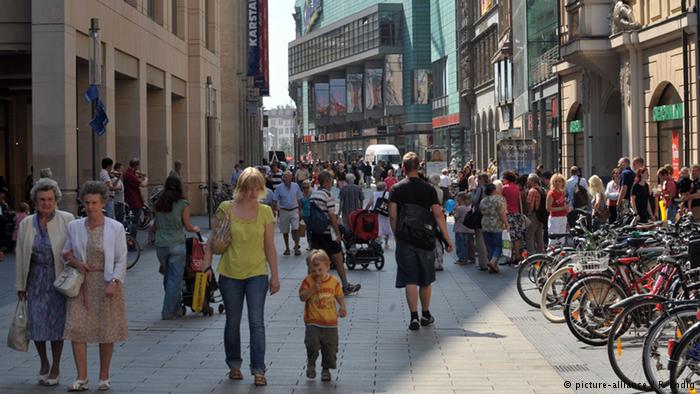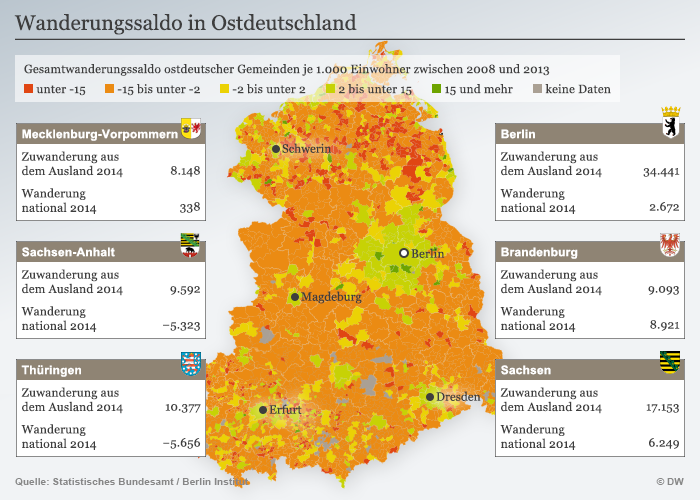Population
Turnaround: Germany’s attractive East
Eastern Germany is attracting more and more people. In return, wander fewer and fewer people in the West. The turnaround, however, benefit only a few large cities. Rural areas lose.

Attracts senior citizens and young families: Leipzig
Since 2012 to attract more people from the West or abroad in the five new Federal States than the inhabitants lose. This comes from a study by the Berlin Institute for population and development. A Trend that only a few large cities has positive effects.
Exodus after the fall of the Berlin wall
East Germany had after the reunification of Germany a veritable Exodus of experienced. The five new Federal States lost approximately 1.8 million citizens. Especially young, qualified people it drew into the attractive West German cities and industrial sites. Structurally weak regions lost up to 40 percent of their inhabitants. The remaining population aged strongly, the number of births has declined.

Klingholz: “The growth is sustainable”
The newly published study “The East is on the move”, supported by the Federal Commissioner for the new Federal States to the Federal Minister for economy and energy, shows: in the Meantime, the East is again recipient of immigration – partially. The turnaround took only a few winners: Leipzig, Dresden, Jena, Erfurt, Rostock, Potsdam, and Weimar. The are only 15 percent of 2695 studied Eastern German municipalities (excluding Berlin) between 2008 and 2013, more immigration than emigration recorded. A Trend which, according to Reiner Klingholz, Director of the Berlin Institute, was foreseeable. “You have a lot of money in the Aufbau Ost is plugged, so that the Region does not bleed out.”
The cities are magnets, so-called “beacons”, especially for young people, a training or study place search. Also, the family finds increasingly in these cities. “They are also for the Elderly became exciting, because they fit,” says Klingholz. Due to the improved labour market, many remained even after the training there.

Hipster City Of Leipzig
Leipzig, for example, moved between 2008 and 2013, around 44,000 more people than it lost. The dynamic centers could be as an “important growth engines” in the otherwise declining population numbers work, says Klingholz. Also as business locations, they would have developed. There would be new companies, from the new Forschungslandschaften emerged to be the Director.
A Trend, but also of the immigration from abroad the slopes, because of the low birth rate is not expected to grow. Through the migration of young people is the population in the East is heavily aged. Thus the ratio between births and deaths, not a stable population.
Rural bleeds
Losers are the rural communities, especially young people in the cities, let them go. The gap between shrinking and growing regions is always larger. As reported 85 per cent of the Eastern German municipalities, according to the study, more emigration than immigration.
Watch Video
03:46
Share
Balance sheet subsidies in East Germany
Send
google+
Tumblr
VZ
Mr. Wong
del.icio.us
Webnews
Furl
Newsvine
Digg
Permalink : http://dw.com/p/1Gz85
Balance sheet subsidies in East Germany
Also, Antonia Milbert from the Federal Institute for construction, urban and spatial research confirms that the migration flows within East Germany increased enormously. Some cities of moderate size there may be no Boom. But you defy the Schrumpfprozess and want to with a customized infrastructure points. They provide for schools, universities, hospitals, the for the population are attractive.
“These places to grow because the surrounding whitespace”, says Reiner Klingholz. “This is bad news for the remote rural regions. Those who have already been in the past few years, a lot of people have lost, further population lose.” There went 90% of the young population away, because they have no training to find, they stay in the cities. Such a structural change would be a lot of money, at best, delay, but could the Trend does not stop.
